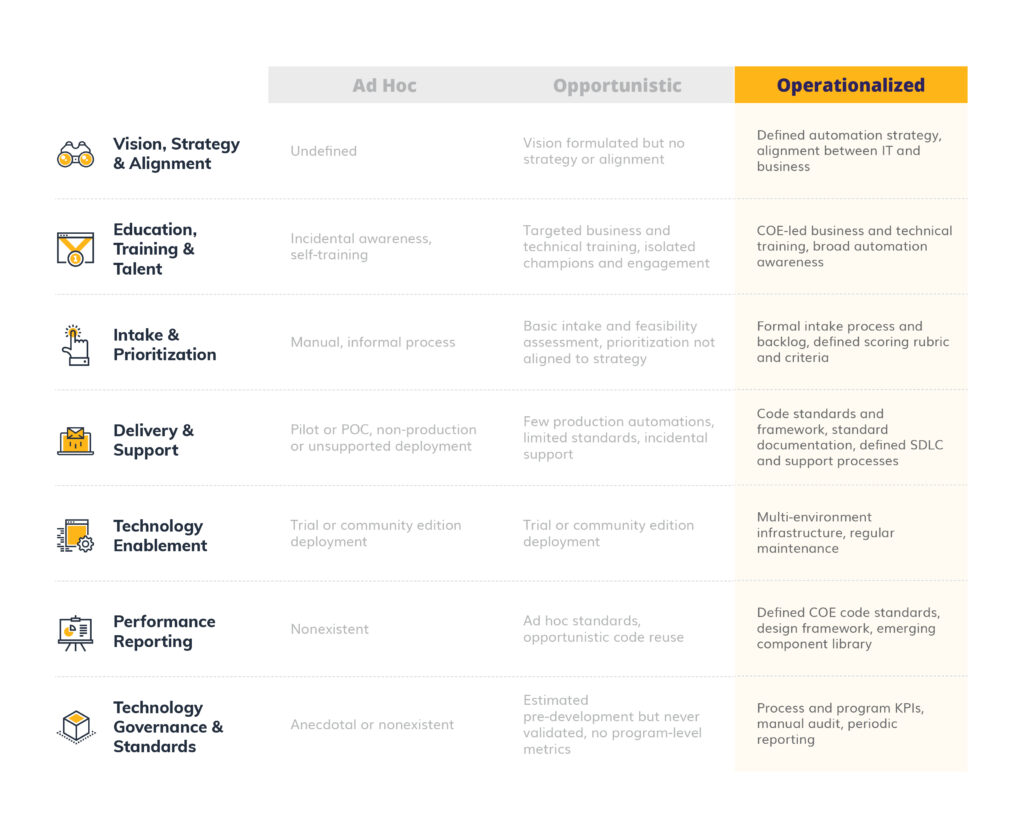In part three of our enterprise automation blog series, we discuss how a center of excellence helps with the operationalize stage of your journey.
Your organization has embarked on its automation journey and has already had small successes. All of this success has been mostly incidental or isolated to this point. As we continue our blog series on maturing automation programs, we will learn how building a center of excellence (CoE) contributes to the “Operationalized” stage of the journey.
Becoming operationalized in your enterprise automation journey means building a solid foundation for scaling your automation program.
At this point, your organization should have a generic understanding of automation or only a single provider or vendor that builds the automations. This builder should create the automations from a proof of concept or highly specific to a small team. All development and support for the automation program are handled in a very scrappy way. Let us look at how we can move to the next stage, focusing on four main areas: organization, operations, enablement and reporting.
Organization
Vision, Strategy and Alignment
In the previous stage, we focused on the next three to five years and envisioning the future of your organization enabled by automation. Now, we’ll transition into a strategy that will guide your company through those years. This strategic approach is critical because it allows you to think about how automation will impact your organization and how that should shape your business strategy going forward.
In building this strategy, you should focus on key business areas that need improvement or extra oversight and governance. You should also consider aligning technology and business stakeholders to ensure you’ve well-defined the strategy. This process will make sure you can move forward confidently knowing your organization is on the right path.
Implementing an automation center of excellence is a suitable place to align stakeholders and drive the strategic intentions of your automation efforts. We highly recommend building out a COE. You can even build it in a federated model as part of a larger COE or governing body. Having a governing body –such as a COE – run your program ensures this alignment, but it also provides a place for technical and subject matter experts to interact and keep the momentum moving forward.
Going back to our lawn care example from earlier in the blog series, the COE is like the family maintaining their lawn. There are many needs like picking up sticks and leaves, edging sidewalks or pruning weeds. After looking at all these maintenance needs, the family identifies how they align with projects or tools they may also need. They can handle sticks and leaves by picking up the large sticks and mowing the rest to mulch them. They can use a lawn sweeper attachment after mowing or simply allow the mulched leaves to stay in the yard. Even further, the family could invest in a leaf blower to consolidate their lawn refuse.
These lawn care needs may seem trivial, but they relate to how you identify business needs. For example, you could identify an automation tool, such as Microsoft’s Power Automate, that does great at system-to-system integration to handle multiple scenarios for you (like the mulching lawn mower with lawn sweeper attachment). Or, you could identify marketing automation needs that require a more specific tool (using a leaf blower instead of allowing leaves to pile up).
Education and Training Talent Under Your Center of Excellence
With the COE as the governing body of your automation program journey, you should identify the appropriate roles and individuals who require training. You should define these roles as standards for areas where you will implement automation.
For example, implementing robotic process automation (RPA) into a new area requires a team champion who understands how RPA bots work and the procedure the bot will complete.
You should also define roles and responsibilities to oversee the automation process – software developers who are experts in their field and quality assurance team members who can identify when errors occur. These quality assurance team members are not specific to departments but are more generalized support for larger areas of the organization.
You can also design the automation program to help broaden automation awareness among the general population by creating assets and education materials with the potential to change the narrative around automation. It is important to note the ultimate goal of the automation program is not to replace people with automation but to help people understand how these changes and updates will affect them.
Operations
Your Center of Excellence’s Intake and Prioritization
Operationalized automation COEs formalize their intake process and backlog by defining scoring rubrics and criteria. This step ensures they can take in more requests and prioritize them so they can use available resources for fulfillment.
You can build a formal intake process using forms or spreadsheets. An analyst who can confirm viability and potential ROI should verify the submitted ideas from users. This analyst should also review other important prioritization metrics such as cost and development time, complexity, expected exception rate, readiness for automation of the team, the ability of the systems to be automated and reusability of components in the automation.
When scoring opportunities, finding the right mix of projects for your organization’s overall goals is important. One of the COE’s jobs is to make sure that even though a project may look like it should be the highest priority, they know when the team should or should not take it on.
For example, if an automation takes data filled in from a website and inputs it into a CRM, this may sound like a great idea. However, the COE knows the roadmap of the CRM tool and would know the company is replacing the CRM in two months with this included feature. This request now becomes a bad project to recommend as a high priority.
Taking those first steps towards intake and prioritization gives the team something to react to, build on and develop into standards or documentation they can use moving forward.
Automation Program Delivery and Support
An operationalized automation delivery and support model has defined standards, processes, tools and documentation for automating a business process. Ensuring that all automations and developers follow the same practices and standards provides you with quicker time to development, cross-training and easier support.
When building these standards and frameworks, consider naming standards across the organization and other key components you use. For example, if there is a standard way for automation or service accounts to bypass multifactor authentication, then document and follow that method throughout the frameworks you build. Additionally, understanding your organization’s software development lifecycle (SDLC) and building that into the planning process of projects sets your program up for success.
Many organizations forget about automation education for support teams. This is the time to provide training or resources to support staff. This could include a full- or part-time support team that aids in these areas as part of the COE. If a helpdesk or support staff already exists, make them aware of automations and how to troubleshoot to ensure the automation program is a success.
Enablement
Technology Best Practices
To best separate development from production, we suggest matching the number of automation environments to the number of environments of your core software. For example, if you have three environments for your core software, then you should also have three automation environments. This practice will help reduce the risk of having a mismatch between the environments and ensure enough resources are available to support them.
Remember to follow best practices around patching, naming standards and other regular maintenance for these environments just as you would for a line of a business system. Automation environments are not only for developers, but they are also important to operations teams. An out-of-date automation environment or data that does not match the production environment can cause issues when running automations in that environment.
It is also best practice to use a naming convention for your automation environments that is different than one used for production systems. This will help avoid confusion among support staff and prevent errors during runtime.
Governance and Standards
Similar to delivery and support, we should also look carefully at code standards and frameworks. The lens we should specifically look through centers on reusability and library components. For example, if building an RPA bot using UiPath, modifying the REFramework will be easier than building your own. This is because developers built the REFramework with RPA in mind, and other developers have already built on top of it.
Taking time to build out a component library of reusable components can also be a worthwhile investment. This is because it will make writing future bots faster and more efficient. With a component library, you can reuse the same components across multiple projects, making your work more consistent.
Reporting on Automation Performance
The goal of reporting at the operationalized stage is to review and audit the performance of your automation program to ensure it is performing as expected. This includes measuring the inputs and outputs of your bot, as well as the time taken for each action. Share these stakeholders and leaders on your center of excellence and across your organization to help provide insight into the benefits of automation.
Conclusion
The operationalized stage is all about making sure the foundations of your automation program are strong enough to support future developments and provide a way to scale the initiative. This includes building a center of excellence, establishing the metrics to measure your program’s success, implementing ways to improve and optimize your bot, and verifying your team is ready for the next steps.
Next, we’ll look at how communicating strategy across the organization can help drive more dedicated automation resources. We’ll also discuss how to scale to use technologies that cover more use cases.


